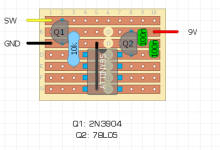CA138
Well-known member
Hi, I have a few Boss and other pedals (some analog, some digital) in my rack that annoyingly power up with the effect disabled.
I believe this solution is the least-intrusive way of solving that issue - it simulates a footswitch press after a short delay when powering up. I would have been happy to buy and install a few of these boards but the website/contact have been unresponsive.
Is anyone aware of a similar solution or DIY board that can do this? I have no experience with Arduino but could put it together and hook it up easily if pre-programmed.
I believe this solution is the least-intrusive way of solving that issue - it simulates a footswitch press after a short delay when powering up. I would have been happy to buy and install a few of these boards but the website/contact have been unresponsive.
Is anyone aware of a similar solution or DIY board that can do this? I have no experience with Arduino but could put it together and hook it up easily if pre-programmed.



